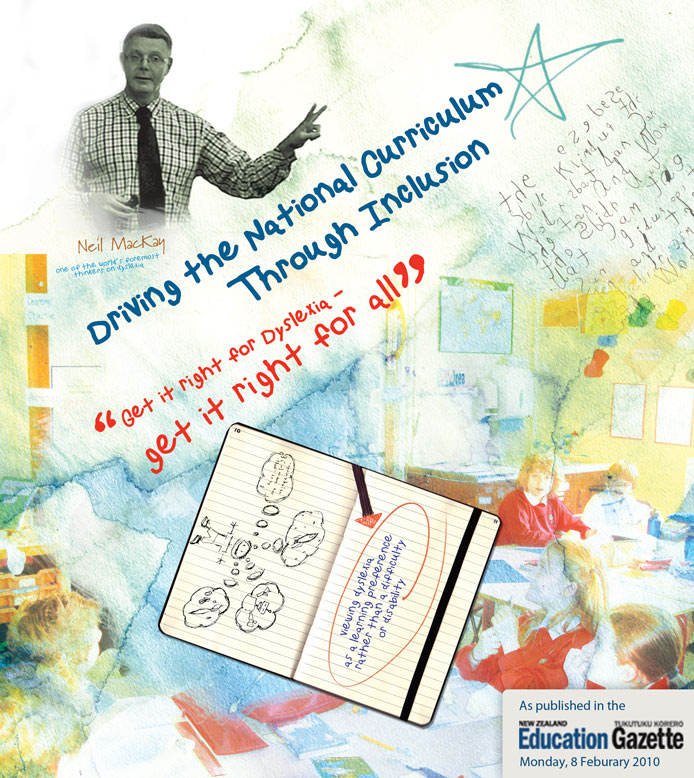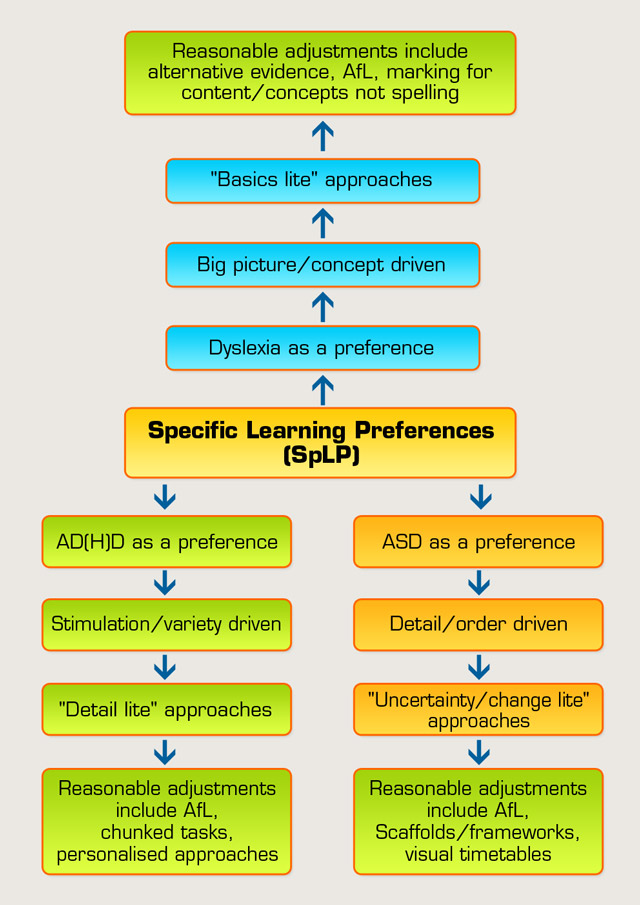 |
|
 |
Three irrepressible forces are heading for a potentially productive collision in
The impact in terms of whole school achievement and attainment could be huge, especially for schools which have the insight and confidence to base their approaches for all students on the principles of dyslexia aware best practice. This school is particularly aware of the needs of growing numbers of non-traditional learners who do not function effectively in a didactic environment as they tend to think faster than they read, write, spell or do number. Instead they are encouraged to present evidence of learning in preferred ways and their teachers value evidence of achievement in alternative forms, such as storyboards, mind maps and flow charts, as much as they value traditional evidence such as paragraphs and essays.
The ethos and culture of the National Curriculum and Standards create the conditions for this school to flourish. But for this to happen it is important to take a long hard look at the implications of these important imperatives and select appropriate starting points - to try and do everything at once will be a recipe for disaster, leading to frustration and innovation fatigue. Confident schools will find themselves following the simple mantra of “ignore, adapt, pick and mix” to get the balance right for their situation. For many, the logical starting point within the eight foundations of curricular decision making will be Inclusion, with real benefits accruing to schools which decide to start with the inclusion of students with dyslexic type learning needs. Because these students exemplify non-traditional learners they are often “stuck” in traditional settings. Fortunately the fine tuning of policy and practice necessary to unstuck them will benefit all students and, by definition, have a positive effect on whole school achievement and attainment. What is uncanny is the match between the curriculum, the standards and the principles of dyslexia aware best practice promoted by the Dyslexia Foundation of NZ’s 4D programme, something which became apparent during the 4D workshops which were delivered across New Zealand in 2009 to over 1300 NZ educators. Much of the best practice promoted by 4D is also validated by central government priorities, especially assessment for learning, differentiation, alternative evidence of achievement and personalization of learning. The principle of “get it right for dyslexia and we get it right for all” requires a paradigm shift towards viewing dyslexia as a learning preference rather than automatically a difficulty or disability. Extending the paradigm to AD(H)D and Asperger’s Syndrome helps make the point. The diagram below shows how viewing each learning need as a preference identifies “drivers” and the “lite approaches” necessary to personalize approaches. Although the strategies shown below will definitely support the inclusion of a range of potentially vulnerable learners there is nothing “special” about them – all of them are within the gift of mainstream class and subject teachers and exemplify what is known in the UK as Quality First Teaching.
Also because the focus here is on learners with dyslexic, AD(H)D or ASD “type” learning preferences rather than those with a formal label, teachers are empowered to “notice and adjust” across a range of similar needs. For example some students from Pacifica may present with dyslexic type learning needs because English is currently a second language. As second language competence improves their dyslexic type needs may disappear and in the meantime they will benefit hugely from dyslexia aware notice and adjust strategies. Most teachers will also recognize the “little professors, also without labels, who benefit from ASD aware approaches. One of the features of our imaginary school is the commitment to differentiation, assessment for learning and alternative evidence of achievement within a culture of personalized learning as promoted by the National Curriculum and supported by National Standards. This commitment is extremely Dyslexia Aware because it gives teachers permission to “notice and adjust” when students are stuck, without needing to refer to specialists and “wait for the label”. So, when a teacher notices students struggling to produce ability appropriate written work, despite clearly understanding the task, there is scope within the National Curriculum to use a range of inclusive strategies to enable them to “show they know” and to assess them in eclectic ways through the National Standards. These strategies could include:
(More information on 1-4 is available on the 4D website – www.4d.org.nz) Our imaginary school is currently an amalgamation of best practice in schools across the country. It has been argued that the most effective and efficient way for individual schools to derive maximum impact from the implementation of the National Curriculum and National Standards is through the Inclusion strand, with a particular focus on meeting the needs of students with dyslexic type learning needs and preferences. The focus on these learners will enable schools to monitor the impact of tweaks in policy and practice within an easily identifiable cohort because experience demonstrates that any classroom based fine tuning to promote dyslexic type learning preferences will benefit all students, regardless of the level of ability or learning need.
Publications include “Removing Dyslexia as a Barrier to Achievement” launched in New Zealand in 2009 during Dyslexia Action Week. His latest book, “Leading on the Inclusion Development Programme” is now available. He is a contributor to “Dyslexia – Successful Inclusion in the Secondary School” by Peer and Reid, “Dyslexia in Context – Research Policy and Practice” by Reid and Fawcett and “The Routledge Companion to Dyslexia” Ed. Gavin Reid. Routledge Publishers 2009.
|


